01 Paul's Garden
'The Ballad of John and Yoko' and the mystery of the Alice statuettes.
April 30th 1969.
It’s exactly 3 months since the legendary rooftop concert, and with the Let It Be / Get Back project stalling, the Beatles have moved onto recording songs for what will become Abbey Road (while still fiddling with January’s project and exploring other songs, as we shall see).
It’s a mixed period for the Beatles, which will culminate in John announcing his departure 5 months later,1 but a joyful one for Paul & John personally. Both have recently married, just 8 days apart (Paul to Linda on the 12th March and John to Yoko on the 20th, in Gibraltar).
It’s also a mixed time in the UK: the voting age is being reduced to 18 from 21, there’s a shiny new tube line (the Victoria Line) and Concorde has made its maiden flight. But fans of Mrs Dale’s Diary (the BBC’s first major serial radio drama) are mourning the show’s demise. And troops have just been deployed in Northern Ireland, signalling the beginning of the Troubles.
Let’s get back to this day, the 30th April, though…
The four Beatles, plus Yoko Ono, gather at 7 Cavendish Avenue - Paul’s pad in leafy St John’s Wood - for a hastily-organised photoshoot. They’re en route to Abbey Road (and EMI studio 2) for George to try another solo on ‘Let it Be’ (not the final one!) and add vocals / FX to oddity B-side ‘You Know My Name (Look Up The Number)’.
But that session doesn’t start till 7pm and there’s other business to attend to first.
The Beatles urgently need a cover for their next single - ‘The Ballad of John and Yoko’. It’s a song about the couple’s wedding in Gibraltar, the Amsterdam bed-in, and more, that John wrote ‘in heat’ and rushed with Paul into the studio to record just a few weeks earlier.2
UK single releases don’t need imagery; the norm is still factory sleeves (as the image below illustrates), but for the US and other territories, a picture is very much de rigueur.
So, given the rush job, Paul’s garden (minutes away from Abbey Road) seems like the obvious choice,3 and it’s Linda who gets the call to wield the camera…
The only time I did an official Beatles photo was when Paul called me up at the last minute from the studio, and said that EMI needed a cover for the sleeve of The Ballad of John and Yoko. I took a color portrait of the group with Yoko.
-Linda McCartney – from Linda McCartney’s Sixties (1992).
Now, given how people have pored over the tiniest details of the Beatles’ work over the years, it’s surprising to me, as an Alice nutter, how little attention has been given to the Alice in Wonderland figures at John & Yoko’s feet. Look! There’s Alice cradling a flamingo, a bearded King of Hearts and his Queen peeking out from behind / between their legs, and on their right, what I think must be the Duchess’ cook - judging by the spoon in her hand.
It’s not 100% clear, but these are still the best photos of the statues we have.
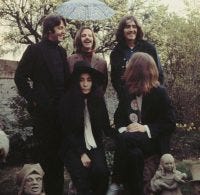
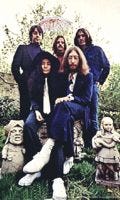
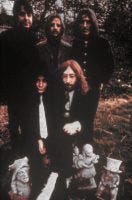
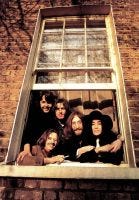
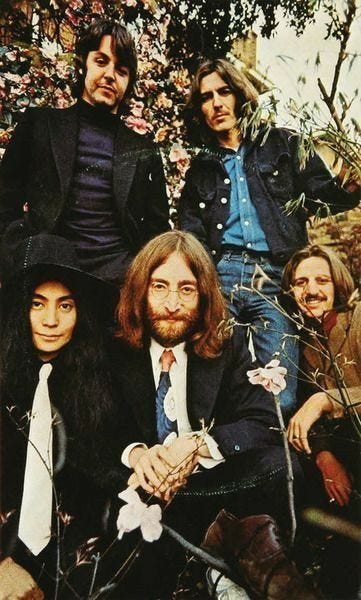
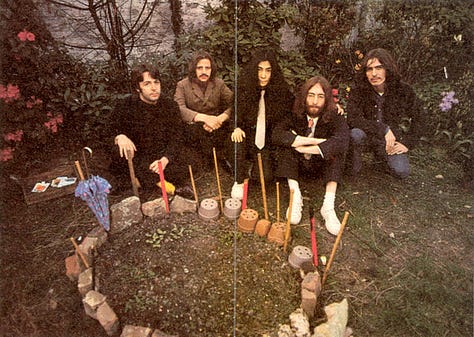
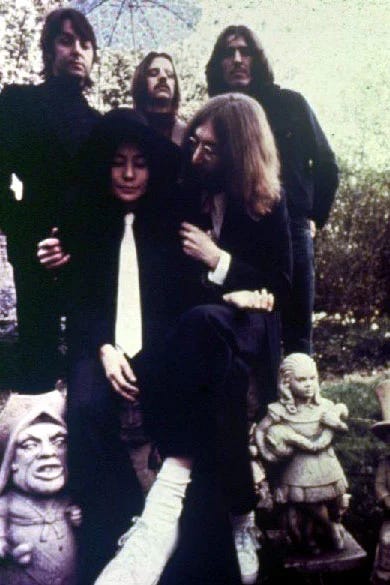
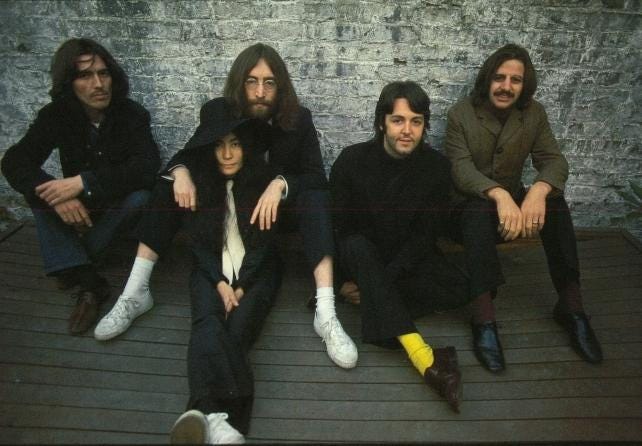
Constant companion Mal Evans is also in tow and takes some additional shots from the side, which give us yet more glimpses of the statues, and the group, from another perspective:
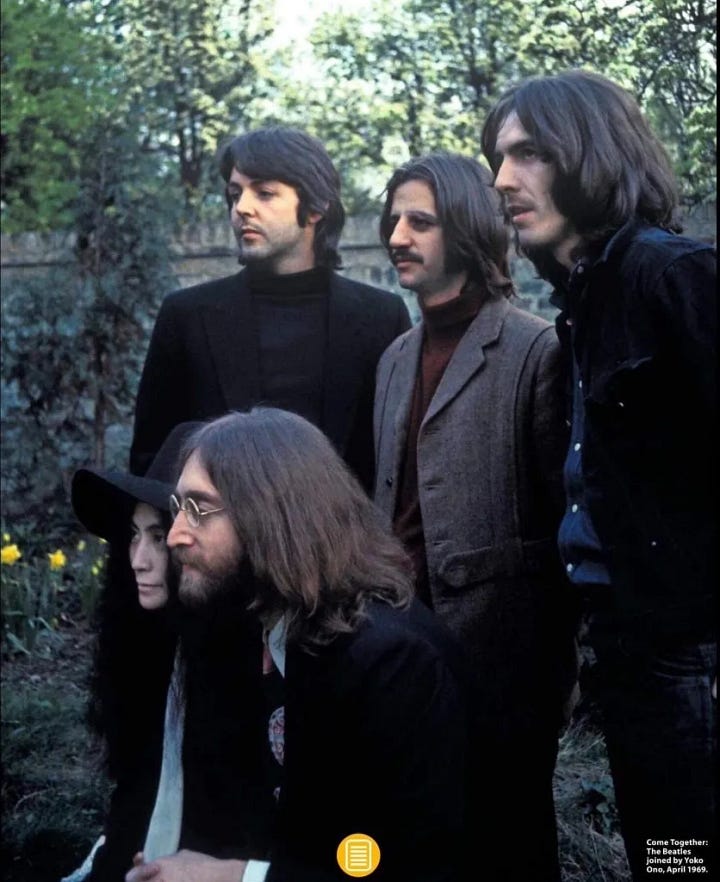
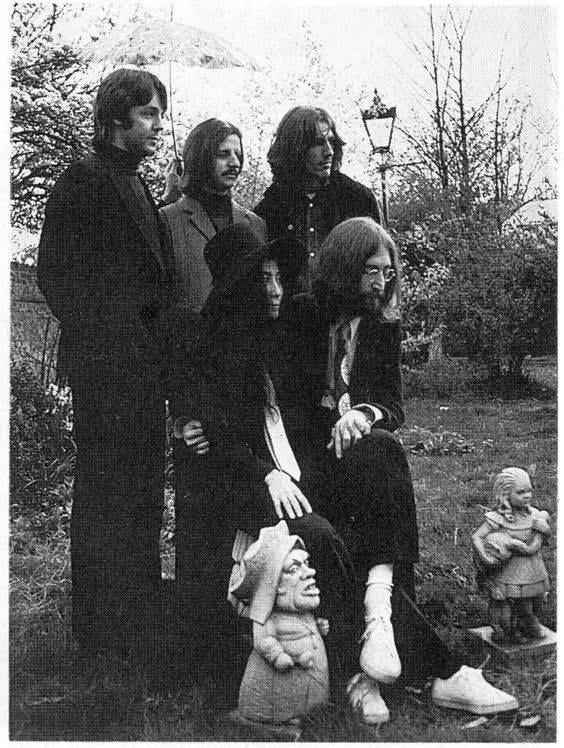
I can’t help thinking how statue-like John & Yoko look in some of these shots, almost as if they were self-consciously playing characters in a strange fairy-tale, with their matching ties, curtain-like hair and carved expressions.
But perhaps I’m overthinking it. Maybe the decision to surround them with the statues was just for compositional interest - as in the circle of upturned plant-pots in one of the other shots - rather than any commentary on the content of the song itself.
But what if it were? Which aspect of Wonderland would be on show?
Well Alice does meet a lot of angry, shouty, short-tempered, “off-with-their-heads”, types on her adventures. And in fact it’s the Queen of Hearts at the trial who’s evoked here, both physically and figuratively in John’s tale of people being ‘on trial’ for crimes that aren’t real.
Wonderland, far from being a comforting, magical, place, often seems pointlessly cruel. And it’s the symbolic grown-ups who are the most cruel and vindictive of all.
I can’t help hearing an echo of aspects of John’s own childhood here, perhaps appropriately for a song about misunderstanding and persecution.
Christ, you know it ain’t easy
You know how hard it can be
The way things are going
They’re gonna crucify me-John Lennon, ‘The Ballad of John and Yoko’
But the real mystery, as far as I’m concerned, is the statues themselves.
Not how they got there, because that much is known: Paul’s brother Mike McCartney, gifted them to him when he moved into Cavendish Avenue in 1966.
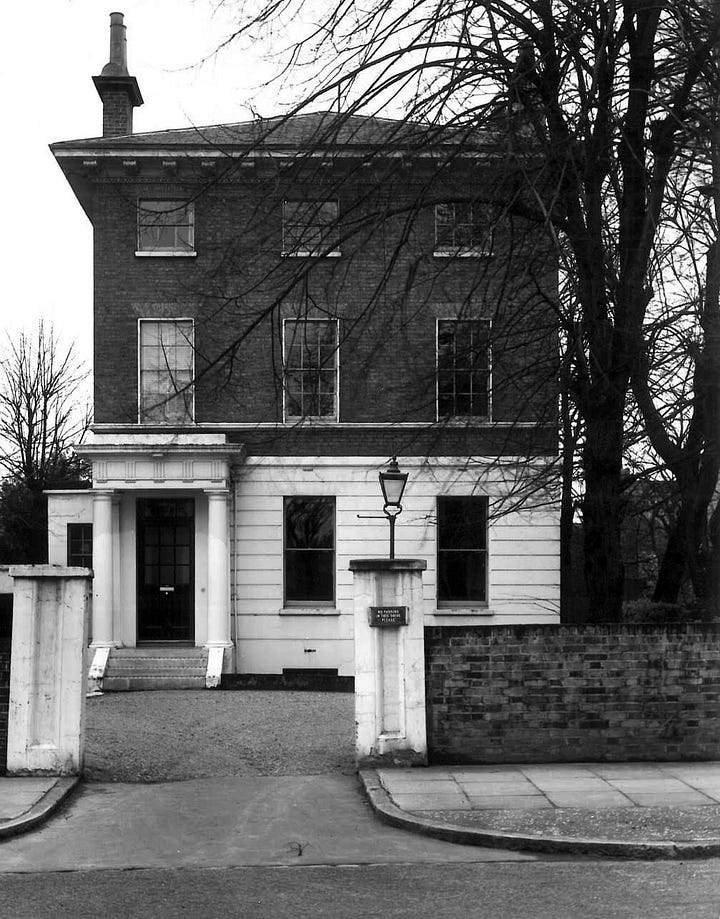
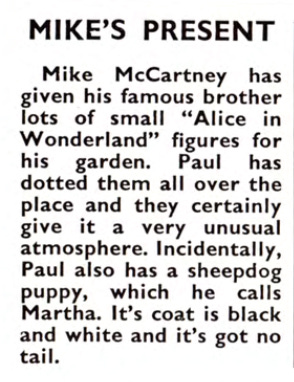
Rather, it’s the context for the giving and ongoing role of the statues at Cavendish Avenue that intrigues me.
What we don’t know much about is how Alice manifested in the lives of the young McCartney brothers… we know the books were favourites of Paul’s, but about Mike we know much less. I’d love to ask them both what role the books played in growing up, post-war.
I do think it’s safe to assume that this was much more than just a random curio; after all gifts between siblings often betray deep understanding and intuition. But equally it’s with songs like ‘Lucy in the Sky With Diamonds’ that the Carroll-esque writing becomes more explicit and that’s a couple of years away still. So there’s something still nascent and developing here.
This is my tantalising sphere of speculation. How much was the interest sparked and rekindled by these statues? They must have been a topic of conversation given how often the other Beatles, not to mention most of the London hippie set, came to visit in those heady years from ‘66 to ‘68.
And then there’s the famous Barry Lategan shoot for the Observer in 1968, where we get to spy a bit of Mad Hatter’s hat above the grass fringe.
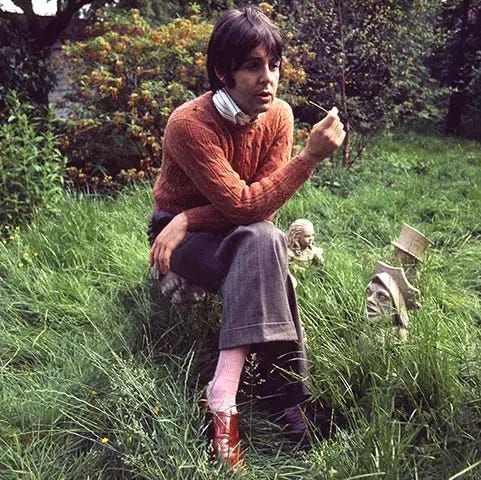
I like to think that there was something very playful about the way these objects moved, or were moved, as we can also see in these candid ‘at homes’. On the left, with Linda, we see them standing in a circle, as though deep in conversation, but in the photo of Paul on Ringo’s drums, they’ve moved to become lawn-observers, stately guardians of the patio border.
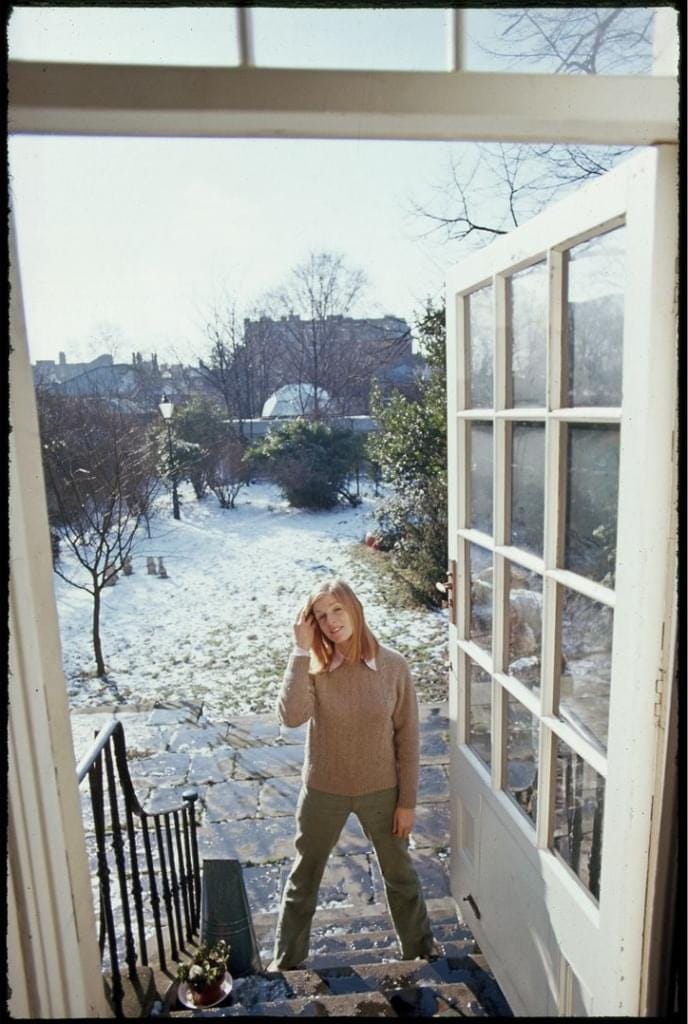
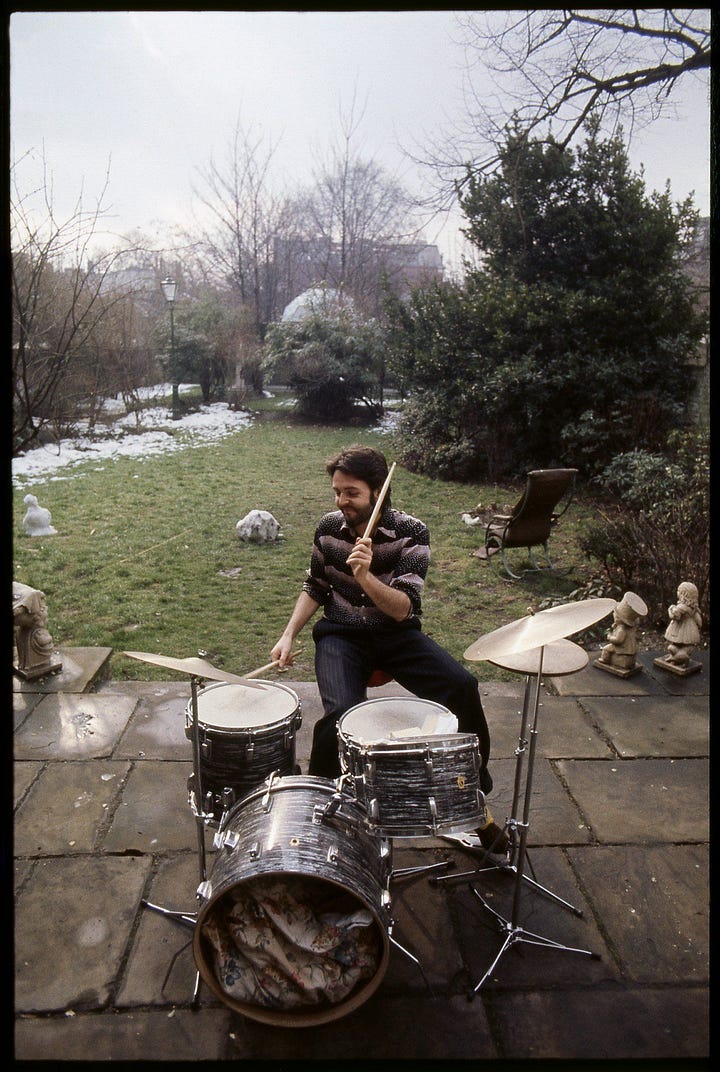
With the Summer of Love round the corner, and Alice and the White Rabbit symbols of the counter-culture, rebels against the symbolic (parental) order, and beacons of a new set of values, it’s not hard to imagine how magical this must all have felt, especially fuelled by Paul’s special brand of tea party:
Paul McCartney invited us to his house on Cavendish Avenue several times to listen to the new songs he was working on in his home music studio. On one of these occasions Paul’s housekeeper treated us to tea and cake but it soon became clear that the sugar cubes were not as innocent as they looked. I had brought my dachshund Amiga and took her roaming through the garden where I went right through the looking glass because it was full of “Alice in Wonderland” statues peaking out of the foliage.
- Marijke Koger Dunham (of 60s art collective The Fool)
We’ll tackle the origins of era-defining art collective The Fool, their predeliction for Tarot cards, ‘The Fool on the Hill’, and the magical painted armoire known as the ‘Wonderwall’ (inspiration for the film of the same name, and yes, Oasis) in another episode.
But that’ll have to wait. Next time it’ll be a story of surrealism (people and things in tight spaces) and how a Magritte painting inspired Apple Corps (and also a fruit-based tech megabrand). Moving from Paul’s garden into the house.
See you there.
Sources:
Paul McCartney Project
The Beatles Bible
Arrive without travelling
Linda McCartney's Sixties: Portrait of an Era (1992)
Mark Lewisohn, The Complete Beatles Chronicle (1992)
With thanks to Heather Simmons, Alice is Everywhere.
September 20th is the day John announces he ‘wants a divorce’ from the Beatles. Manager Allen Klein persuaded the Beatles to keep quiet until the silence was broken by Paul’s first solo release, McCartney. Leading to Paul being branded as the one who broke up the Beatles.
The pair recorded all instruments and finished the song in one session, on April 14th 1969.
As The Beatles Bible reminds us, “the three-storey Regency townhouse was purchased from a physician named Desmond O’Neill for £40,000. A short walk to EMI Studios on Abbey Road, it often functioned as a base for the group for meetings before or after they were recording”.


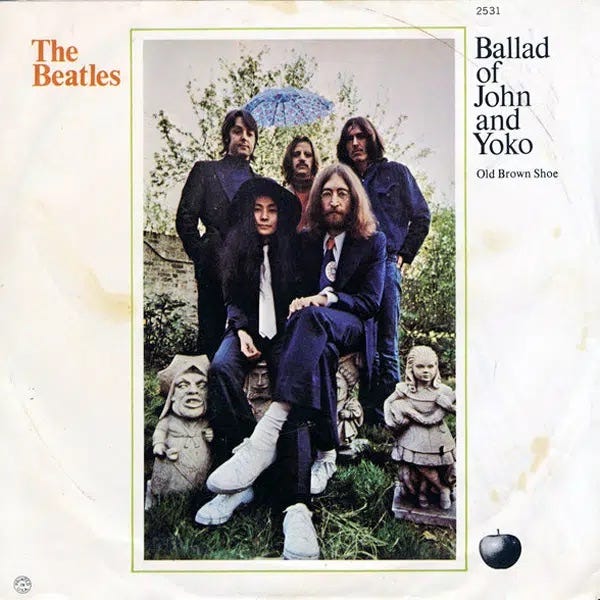

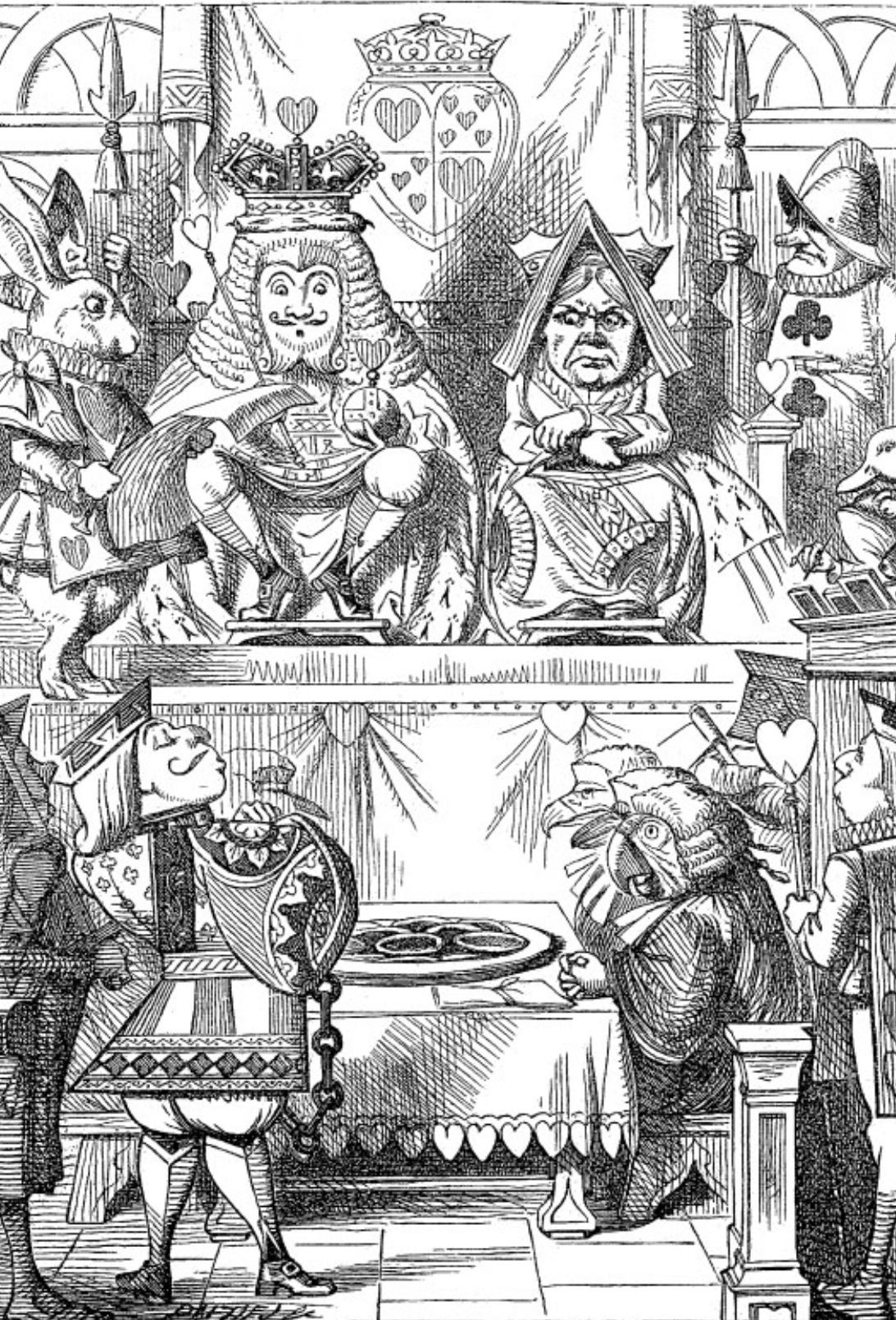
Great story-telling!